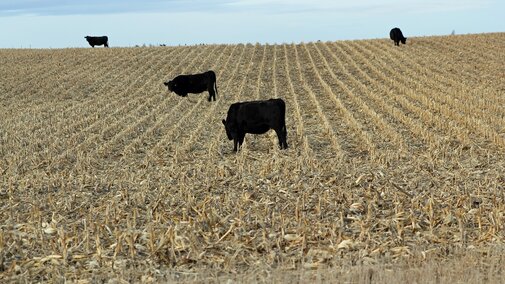New updates make the Crop Residue Exchange even easier to use to link cattle producers and available grazing resources. Crop producers who have listed residue available for grazing in the past are encouraged to log in and update their listings on the Exchange for the fall and winter grazing season.
Recent updates to the Exchange have expanded its geographical reach to include large portions of the states that surround Nebraska. Crop producers in much of Iowa, Missouri, Kansas, Colorado, Wyoming, and South Dakota can now list fields they have available for grazing.
Another update allows livestock producers to save their searches and receive an email notification when a crop producer lists something matching their criteria. There is a lot more searching going on than we have listings. If a crop producr creates a new listing, odds are pretty good that in the near future several livestock producers will be receiving an email letting them know about it.
In addition to providing a winter feed resource, grazing corn residue can increase the amount and rate of corn residue breakdown. When grazed at proper stocking rates, small but positive impacts on subsequent crop production after grazing have been observed. University of Nebraska-Lincoln recommendations for establishing corn residue stocking rates are based on 50% utilization of leaves and husks (8 pounds per bushel or 20% of the total corn residue). Some additional corn residue disappears through trampling and wind loss, but there has been no increased erosion risks when only 40% to 50% of the corn residue was removed through grazing.
Getting Started with the Crop Residue Exchange
After establishing a log-in account on the Crop Residue Exchange, producers can draw out the plot of land available for grazing by using an interactive map and entering basic information about the type of residue, fencing situation, water availability, and dates available. They also need to provide their preferred contact information. The land available for grazing can be described as a “Residue Type” (corn, wheat, sorghum, other) or pasture. Pricing can be listed as a cost per acre or a cost per head per day. Livestock producers can search the Crop Residue Exchange database for grazing available within a radius for the location of interest. Livestock producers must be logged in to view the contact information attached to each listing.
The Crop Residue Exchange came online in August 2017. To date 281 registered users have posted 45 listings for grazing. Over 6,000 searches for grazing resources have been conducted on the Exchange and almost 600 views of contact information for available listings have occurred. The Exchange continues to expand in usage as well as features available to better connect livestock producers with forage resources.
The Crop Residue Exchange is made possible with funding support from Nebraska Extension and the Northern Plains Climate Hub.

